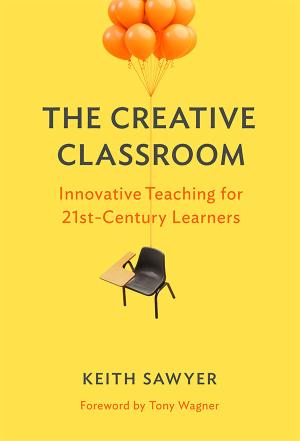Resources
One-page Teaching Tactic that has students write creatively in the voice of an ancient person to help them learn to exercise sensitivity to historical, social, political, and social contexts of ancient documents and gain proficiency in reading texts critically and sympathetically.

The Creative Classroom presents an original, compelling vision of schools where teaching and learning are centered on creativity. Drawing on the latest research as well as his studies of jazz and improvised theater, Sawyer describes curricula and classroom practices that will help educators get started with a new style of teaching, guided improvisation, where students are given freedom to explore within structures provided by the teacher. Readers will learn how to improve learning outcomes in all subjects—from science and math to history and language arts—by helping students master content-area standards at the same time as they increase their creative potential. This book shows how teachers and school leaders can work together to overcome all-too-common barriers to creative teaching—leadership, structure, and culture—and collaborate to transform schools into creative organizations. (From the Publisher)
The article discusses two versions of a complex role‚Äêplaying exercise in undergraduate courses on Buddhism. The pedagogical exercise demonstrated how imagination cultivated through creative writing could be used to enhance learning about history, culture, and religion. Students were also challenged to generate an understanding of religious practice that arose from both cognitive and sensory learning. The project showed that by interacting with a form of engaged pedagogy that worked with the imagination, without leaving the classroom students developed a deep care for and active engagement with communities located spatially and temporally far from home. With empathy and critical reflection, they came to see how religious meaning is constructed at a communal level through embodied action and emotional sensibility.
This article considers the “create your own religion” or “fictive religion” assignment as a pedagogical tool, contextualizing it within the scholarship of teaching and learning, and positioning it as a tool for broad adoption in a variety of courses. I argue that we ought to conceptualize the fictive religion assignment as an instructional game, and make use of scholarship on teaching through games as a foundation for my analysis. While I offer the example of my own fictive religion assignment as a case study, the overall argument is a theoretical one, namely that the assignment works because of the nature of games.
Role‚Äêplaying games have been a part of scholarly conversations about pedagogy for several decades. However, more work is needed in understanding how gaming pedagogy can best fit with and augment particular disciplines. After providing two examples of role‚Äêplaying games that have been used successfully in teaching the New Testament, this article argues that role‚Äêplaying games contribute to theological and religious studies classrooms by forming positive values (e.g. openness to multiple viewpoints, civility, and empathy) and assisting students in integrating their faith and learning. Because of the low‚Äêrisk settings that games provide, students can practice skills that increase their achievement of learning outcomes and contribute to their value formation and faith formation.
Games offer unique possibilities for learning, and text‐based interactive fiction (“IF”) in particular lends itself as a low barrier to entry for instructors and students wishing to build interactive narrative games. Understanding by Design provides a framework by which to determine the best possible places for instructor‐ and learner‐built IF in any given course, whether face‐to‐face or online. A thick description of how an instructor conceived and developed two IF games follows, explicitly tied to course‐design considerations like learning goals and assessment performances. The value of IF as a student project is explored, and finally an appendix provides resources for instructors and students to begin building their own interactive fiction.
In our ostensibly secular age, discussing the real-world contexts and impacts of religious traditions in the classroom can be difficult. Religious traditions may appear at different times to different students as too irrelevant, too personal, or too inflammatory to allow them to engage openly with the materials, the issues, and each other. In this “Design & Analysis” article Aaron Ricker describes an attempt to address this awkward pedagogical situation with an experiment in role-play enacted on the model of a mock conference. This description is followed by four short responses by authors who have experimented with this form of pedagogy themselves. In “Conplay,” students dramatize the wildly varying and often conflicting approaches to biblical tradition they have been reading about and discussing in class. They bring the believers, doubters, artists, and critics they have been studying into the room, to interact face-to-face with each other and the class. In Ricker's experience, this playful and collaborative event involves just the right amount of risk to allow high levels of engagement and retention, and it allows a wide range of voices to be heard in an immediate and very human register. Ricker finds Conplay to be very effective, and well worth any perceived risks when it comes to inviting students to take the reins.
Online learning tools that teach ethical awareness, critical thinking and ethical decision making. Several “products” are available through contract, including the Ethical Lens Inventory providing students with an awareness of their ethical orientation, Hot Topics Simulations, Ethics Exercises, and the Core Values Simulations